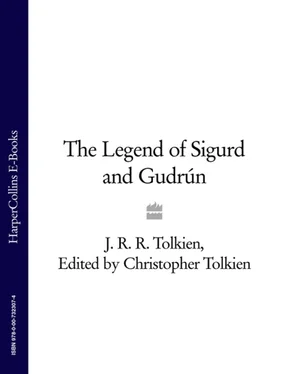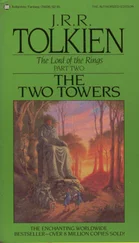J. Tolkien - The Legend of Sigurd and Gudrún
Здесь есть возможность читать онлайн «J. Tolkien - The Legend of Sigurd and Gudrún» — ознакомительный отрывок электронной книги совершенно бесплатно, а после прочтения отрывка купить полную версию. В некоторых случаях можно слушать аудио, скачать через торрент в формате fb2 и присутствует краткое содержание. Жанр: Старинная литература, на английском языке. Описание произведения, (предисловие) а так же отзывы посетителей доступны на портале библиотеки ЛибКат.
- Название:The Legend of Sigurd and Gudrún
- Автор:
- Жанр:
- Год:неизвестен
- ISBN:нет данных
- Рейтинг книги:5 / 5. Голосов: 1
-
Избранное:Добавить в избранное
- Отзывы:
-
Ваша оценка:
- 100
- 1
- 2
- 3
- 4
- 5
The Legend of Sigurd and Gudrún: краткое содержание, описание и аннотация
Предлагаем к чтению аннотацию, описание, краткое содержание или предисловие (зависит от того, что написал сам автор книги «The Legend of Sigurd and Gudrún»). Если вы не нашли необходимую информацию о книге — напишите в комментариях, мы постараемся отыскать её.
The Legend of Sigurd and Gudrún — читать онлайн ознакомительный отрывок
Ниже представлен текст книги, разбитый по страницам. Система сохранения места последней прочитанной страницы, позволяет с удобством читать онлайн бесплатно книгу «The Legend of Sigurd and Gudrún», без необходимости каждый раз заново искать на чём Вы остановились. Поставьте закладку, и сможете в любой момент перейти на страницу, на которой закончили чтение.
Интервал:
Закладка:
37–48 The narrative elements of the Hunnish messenger and the ring and runes sent by Gudrún are derived from both Atlakviða and Atlamál. The name Vingi is from Atlamál, but ‘Cold fell his cry’ (38) comes from Atlakviða, where Atli’s messenger, there called Knefröðr, kallaði kaldri röddu ‘cried with a cold voice’, which as my father noted bore here a distinct sense, ‘ill-boding, fateful’.
From Atlakviða come also the great gifts offered by Atli, and the words of Gunnar and Högni concerning Atli’s invitation. In Atlakviða Gudrún’s warning takes this form, in Högni’s words:
Hár fann ek heiðingja
riðit í hring rauðum.
Ylfskr er vegr okkar
at ríða örindi.
(I found a hair of the heath-roamer / wound in the red ring./ Treacherous as a wolf is the road for you and me / if we ride on this errand.) But in Atlamál the wolf’s hair is eliminated, and Gudrún sent a message in runes, which Vingi altered before he delivered it.
In the Lay of Gudrún both motives are combined (stanzas 44–5), and in this my father was following the Saga and the note entitled Dráp Niflunga in the Codex Regius. This latter adds that the ring was Andvaranaut (taken by Sigurd from Brynhild and given to Gudrún: but not so in the Lay of the Völsungs, see the note to IX.9–10).
39 ‘boon’: request, entreaty.
40 ‘dights’: prepares, makes ready.
42–58 I set out here the interweaving of sources in this passage in some detail, since it exhibits very clearly my father’s narrative method in this poem.
In Atlakviða , Gunnar asks his brother why they should be tempted by Atli’s bounty when they themselves own such wealth and such arms (see the Lay stanzas 42–3), and Högni, not replying directly, speaks of the wolf’s hair twisted round Gudrún’s ring. With no further direct indication of Gunnar’s thoughts, he at once makes the decision to go, crying Úlfr mun ráða arfi Niflunga, the wolf shall possess the heritage of the Niflungs, if he does not return. In Atlamál , on the other hand, neither Gunnar nor Högni are shown to hesitate at all. The runic message that replaced the wolf’s hair of Atlakviða causes them no disquiet. It is only subsequently that Högni’s wife Kostbera examines the runes and perceives that they have been overlaid on those originally cut; but Högni dismisses her warning, as he also dismisses her warning dreams. Gunnar’s wife Glaumvör likewise has oppressive dreams, but they too are dismissed by Gunnar; and the brothers set out next morning. Kostbera and Glaumvör appear only in Atlamál and are not taken up into the Lay of Gudrún.
In the Saga a further element is introduced, in that Vingi, seeing that the brothers have become drunk, tells them that Atli, now aged, wishes them to become the rulers of his kingdom while his sons are so young (see stanzas 51–2 in the Lay). It is this that makes Gunnar decide to go, and Högni reluctantly to agree, before the closer examination of the runes and the telling of the dreams take place.
In the Lay my father has taken elements from both the Eddaic lays and from the Saga, but rearranged the context, so that the implications are somewhat altered. Gunnar’s scorn for Atli’s offer and Högni’s warning about the wolf’s hair are preserved, but Gunnar is now persuaded to accept the invitation by the ostensible meaning of Gudrún’s runic message (45). It is Grímhild, not Kostbera, who warns that the runes have been tampered with, and that the underlying meaning was quite other – and this leads Gunnar to tell Vingi that he will not now come (49). This is the occasion of Vingi’s final seduction (51–2); and though Högni remains scornfully unconvinced (53–4), Gunnar, who had ‘deep drunken’, cries out echoing the words of Atlakviða : ‘Let wolves then wield wealth of Niflungs!’
The scene ends with a return to the runes: Högni observing heavily that when Grímhild’s counsel ought to be attended to they dismiss her warning, and Vingi swearing, in an echo of his words in Atlamál , that the runes do not lie. Gunnar’s character is maintained: see p.52(ii).
50 ‘rune-conner’: one who pores over, closely examines, runes.
54 ‘fey saith my thought’: I take, but doubtfully, the word ‘fey’ here to mean ‘with presage of death’.
59 ‘few went with them’: in Atlakviða there is no mention of any companions of Gunnar and Högni; in Atlamál they had three, Högni’s sons Snævar (named in stanzas 87–8 of the Lay) and Sólar, and his wife’s brother Orkning.
59–63 On their journey to the land of the Huns, as my father wrote of the passage in Atlakviða (see p.313), ‘the Niflungs ride fen and forest and plain to Atli’. Stanza 62 is derived from Atlamál , where the furious rowing of Gunnar and Högni and their companions is described; but in the Lay the localized Scandinavian scene of Atlamál is not intended – they are crossing the Danube.
60 ‘fey’: fated to die.
62 lines 7–8: this also is derived from Atlamál . My father remarked in a lecture that the abandoning of the boat by the Niflungs, since they hoped for no return, seems to be a detail that belongs to the oldest form of the legend as it reached the North, since it is found also in the German Nibelungenlied.
65–67 While the great courts of Atli are obviously quite differently conceived from the farmstead of Atlamál , Högni’s beating on the doors derives from it, as does the slaying of Vingi – though in Atlamál they struck him to death with axes.
68–92 In Atlakviða there is no fighting when Gunnar and Högni come to Atli’s halls. Gudrún meets her brothers as they enter and tells them that they are betrayed. Gunnar is at once seized and bound (and it is here that he is called vin Borgunda ‘lord of the Burgundians’, the only surviving trace in Old Norse literature of the Burgundian origin of the Gjúkings: see p.228, note on VII.15). Högni slew eight men before he was taken.
In Atlamál, on the other hand, as in the German Nibelungenlied , there is fierce fighting on the arrival of Gunnar and Högni, and Gudrún, in this poem leaving the hall and coming to her brothers outside, takes part in it and herself strikes down two men. The fighting lasted through the morning, and eighteen of Atli’s men were slain before Gunnar and Högni were taken. Then Atli speaks and laments his marriage and the loss of his men.
In the Lay this part of the narrative is greatly extended beyond what is told in either of the Eddaic lays or in the Völsunga Saga . The Saga introduces the idea of a lull in the fighting, not found in Atlamál , when Atli spoke of his loss and his evil lot, before the battle was rejoined and the brothers forced their way into the hall (cf. stanzas 71 ff. in the Lay). But after fierce fighting Gunnar and Högni were taken prisoner; whereas in the Lay the result of the assault is that they hold Atli at their mercy – and Gudrún persuades them to show it.
The Lay is far removed from Atlamál in the portrait of Gudrún, who is naturally not here presented as a fierce warrior-woman; and an entirely new element is introduced in the presence of Gothic warriors at Atli’s court (83), on whom Gudrún calls for aid and who rise against their Hunnish masters (81–6); see the note to 86.
68 Budlungs: men of Budli (Atli’s father).
80 ‘A wolf they gave me’: see the note to stanza 22.
‘Woe worth the hour’: see the note to the Lay of the Völsungs, IX.29.
86 The introduction in the Lay of the Burgundians’ newfound allies in the Goths at Atli’s court leads to these references to ancient Gothic names remembered in old lays. This stanza is an innovation of my father’s.
Читать дальшеИнтервал:
Закладка:
Похожие книги на «The Legend of Sigurd and Gudrún»
Представляем Вашему вниманию похожие книги на «The Legend of Sigurd and Gudrún» списком для выбора. Мы отобрали схожую по названию и смыслу литературу в надежде предоставить читателям больше вариантов отыскать новые, интересные, ещё непрочитанные произведения.
Обсуждение, отзывы о книге «The Legend of Sigurd and Gudrún» и просто собственные мнения читателей. Оставьте ваши комментарии, напишите, что Вы думаете о произведении, его смысле или главных героях. Укажите что конкретно понравилось, а что нет, и почему Вы так считаете.












